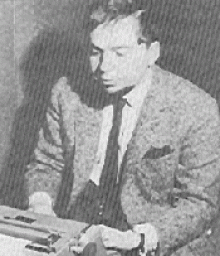
“My work simply affirms that at all times man must be conscious that he will die, which means that eroticism is, like poetry, the only moment in which we can demolish an implacable history.” Only two years after describing his own poetry in this way Jorge Gaitán Durán met an untimely death, at the age of 38. In his short lifetime, however, he became widely known as a major cultural figure, active in many different fields.
Jorge Gaitán Durán was born in Pamplona, Norte de Santander, Colombia, on February 12, 1924. At the age of 16, he travelled to Bogotá, the capital city, to study law. It was there that he began to take part in Colombia’s cultural life and, in 1945, to publish art and literary criticism, as well as poems and stories, in important newspapers and reviews. On April 9, 1948, after the murder of the liberal political leader Jorge Eliécer Gaitán, Durán participated in the seizure of the Colombian National Radio Station, resulting in his being accused of sedition by the conservative government.
Once absolved of blame, and after surviving a murder attempt against him, he left for Europe in 1950. There, and in Asia, he travelled to several countries and, wherever he went, became closely involved in the cultural movement, at that time much influenced by the ideological and aesthetic postwar polemics around existentialism and marxism, the colonial wars and the Cold War. Most of the time he lived in Paris, where he attended cinema courses at the Institut des Hautes Etudes Cinématographiques and lectures given by Maurice Merleau Ponty at the Collège de France.
In 1954, after a brief stay in Brazil, he returned to Colombia to found, together with the Colombian critic, Hernando Valencia Goelkel, the review Mito. Between 1955 and 1962, this periodical, in which Colombian and Latin American writers published their work, established itself as one of the most important reviews on the continent. Through it, Colombian intellectuals protested against restrictions to freedom in Colombia and other parts of the world.
While he led this editorial work, Jorge Gaitán Durán was a university professor. In addition, he took the place of Gabriel García Marquez on the newspaper El Espectador, where he published book and film reviews, as well as writing a column, “In and Out”, on topical subjects relating to national politics and foreign affairs. Previously he had written for La calle, the weekly of the Liberal Revolutionary Movement, which was a splinter group of the liberal party during the first years of the National Front created by the political leaders to put an end to the violence of the 1950s.
On 18 February 1962, the well-known poet Eduardo Carranza led a national homage to Gaitán on the occasion of the publication of Durán’s volume of poetry, Si mañana despierto. Two months later, Durán travelled to Paris. On his return journey, on June 22, 1962, he was killed when the plane he was travelling in crashed, just before it was due to land on the Caribbean island of Guadeloupe.
By the time of his death, Durán had published the poetry volumes Insistencia en la tristeza (1946), Presencia del hombre (1947), Asombro (1951), El libertino (1954), Amantes (1959) and Si mañana despierto (1962); the essays La revolución invisible (1959) and Sade: El libertino y la revolución (1961); and the libretto of the opera Los hampones (1961), which was performed in Bogotá, the music being composed by Luis Antonio Escobar and scenery created by the painter David Manzur.
Gaitán Durán’s poetry was influenced by his reading of authors such as Octavio Paz, Jorge Luis Borges, Bertolt Brecht, Jean Genet, Antonio Machado, Henry Miller, Victor Segalen, René Char and, especially in his books Amantes and Si mañana despierto, Georges Bataille. But Bataille’s central interest, eroticism, is present in all of Gaitán Durán’s works.
In fact, in the poetry of Gaitán Durán bodies appear as solitary unities that are joined in the erotic moment in an attempt to ward off death through desire. They rebel against their mortal condition and attempt to liberate themselves from whatever prevents them following their vital instincts and living an authentic existence. It is for this reason that the author asserted in 1959: “Sometimes I feel that only the tremulous sun of desire and of pleasure can rise and shine for an instant in the ethical night of modern life.”
This concern for ethics linked to aesthetics is another frequent theme in the work of Gaitán Durán. The poet assumes that he is a man of his time and, facing its demands as well as those of his milieu, recognises that “one must do away with the monstrously banal idea that intellectual quality is independent of human quality”. This expresses a compromise not with an ideology but with the human condition, within a very wide concept of reality and art.
Other dominant ideas in this poetry arise from the poet’s interest in studying the historical, cultural and social milieu of his time. It is through these themes, and his independence and intellectual curiosity, that one can understand why Jorge Gaitán Durán was, as Jean Paul Sartre said of Albert Camus, “the admirable conjunction of a person and a work of art”.
Translated by Nicolás Suescún.
Poems
THE LAND THAT WAS MINE
LOVERS
LOVERS II
I JUST WANT
I KNOW I’M ALIVE . . .
NOCTURNAL MOMENTS
DEATH COULD NOT BEAT ME
THE INSTANT
Bibliography
Poetry
Asombro (1949)
El libertino (1954)
Amantes (1958)
Si mañana despierto (1961)
Prose
La revolución invisible (1959)
El libertino y la revolución (on De Sade)
Diaries (published after his death)
Websites
A Media Voz
Jorge Gaitán Durán’s poems
Language: Spanish
Banco de la República
Essay by Hernando Valencia Goelkel
Language: Spanish
Jornal do Poesia
Essay by Jaime García Maffla
Language: Spanish
Espéculo
Essay by Nelson González Leal
Language: Spanish

